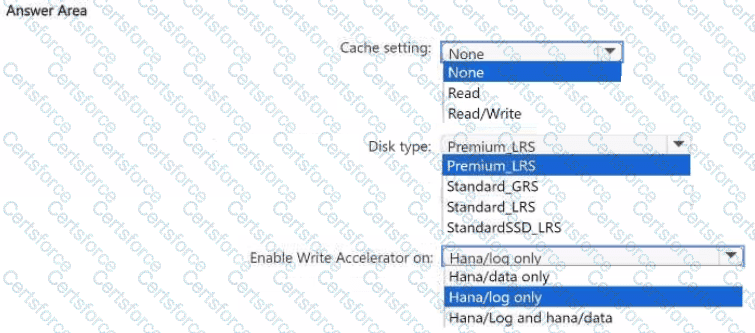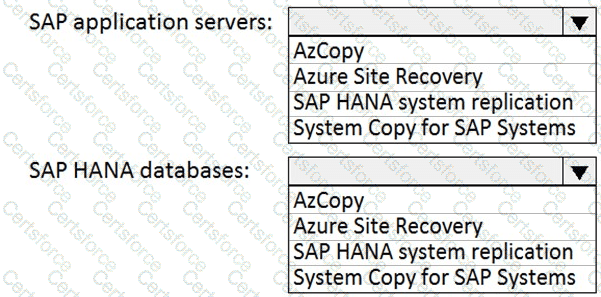Your on-premises network contains the following:
• A 1-Gbps internet connection
• An SAP HANA 1.0 instance that has a 4-TB database
• An SAP landscape that uses SUSE Linux Enterprise (SLES) 12
You have an Azure subscription that contains a virtual machine. The virtual machine is of the M64s SKU and runs SLES 15 and HANA 2.0.
You need to migrate the database to the virtual machine and upgrade the database to HANA 2.0. The solution must meet the following requirements:
• The migration must be performed during a weekend.
• The database can be offline during the migration.
Which migration method should you use?
You have an on-premises SAP NetWeaver development landscape that contains the resources shown in the following table.

You have a 500-Mbps ExpressRoute circuit between the on-premises environment and a virtual network.
You plan to migrate the landscape to Azure.
What should you include in the solution?
You migrate an on-premises instance of SAP NANA that runs SUSE Linux Enterprise Server (SLES) to an Azure virtual machine.
You project that in two years, you will replace the virtual machine with a larger virtual machine within the same flexibility group.
You need to recommend solutions to minimize HANA deployment costs during the next three years. The solutions must not affect the availability SLAs.
Which two solutions should you recommend? Each correct answer presents a complete solution
NOTE: Each correct selection is worth one point.
You deploy an SAP environment on Azure.
Your company has a Service Level Agreement (SLA) of 99.99% for SAP.
You implement Azure Availability Zones that have the following components:
* Redundant SAP application servers
* ASCS/ERS instances that use a failover cluster
* Database high availability that has a primary instance and a secondary instance
You need to validate the load distribution to the application servers. What should you use?
You have an on-premises deployment of SAP HANA that contains a production environment and a development environment.
You plan to migrate both environments to Azure.
You need to identify which Azure virtual machine-series to use for each environment. The solution must meet the following requirements:
• Minimize costs.
• Be SAP HANA-certified.
What should you identify for each requirement? To answer, select the appropriate options in the answer area. NOTE: Each correct selection is worth one point.

You plan to deploy a highly available SAP development landscape in Azure.
You need to automate the deployment. The solution must meet the following requirements:
• Ensure that SAP services can be managed by using the Azure portal.
• Create a reproduceable deployment.
• Minimize administrative effort.
What should you use? To answer, select the appropriate options in the answer area. NOTE: Each correct selection is worth one point.

You have an SAP Cloud Platform subscription and an Azure Active Directory (Azure AD) tenant.
You need to ensure that Azure AD users can access SAP Cloud App by using their Azure AD credentials.
What should you configure?
You plan to deploy SAP HANA to an Azure virtual machine for a production landscape.
You need to stripe multiple disks together by using the HANA indexserver.
How should you configure the Azure disks? To answer, select the appropriate options in the answer area.
NOTE: Each correct selection is worth one point.

A company named Contoso, Ltd. has users across the globe. Contoso is evaluating whether to migrate SAP to Azure.
The SAP environment runs on SUSE Linux Enterprise Server (SLES) servers and SAP HANA databases. The Suite on HANA database is 4 TB.
You need to recommend a migration solution to migrate SAP application servers and the SAP HANA databases. The solution must minimize downtime.
Which migration solutions should you recommend? To answer, select the appropriate options in the answer area.
NOTE: Each correct selection is worth one point.

You plan to deploy a highly available SAP NetWeaver system to Azure virtual machines on SUSE Linux Enterprise Server (SLES) for SAP Applications.
You need to configure a load balancer that will be deployed in front of the ABAP Central Services (ASCS) tier. The solution must minimize the number of required load balancing rules.
What should you configure? To answer, select the appropriate options in the answer area.
NOTE: Each correct selection is worth one point.
